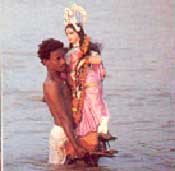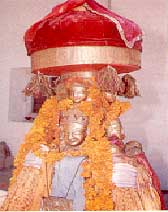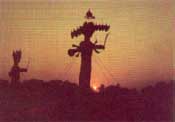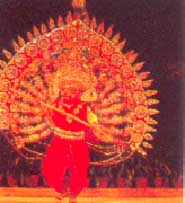DURGA PUJA
Durga Puja is a time for people to show their gratitude to Mother Nature or the Goddess Durga. It is the apt period to revive oneself after the agonizing period of rains followed by deadly epics.

Durga is depicted as a powerful and beauteous Goddess, riding a raging lion, holding aloft ten weapons in her ten hands. Above the head of the Goddess broods the small figure of Shiva, her Lord, the essence of Goodness. On either side are seated her four children: Saraswati, the Goddess of learning, Lakshmi, the Goddess of Prosperity, Ganesh, the God of fulfillment and Karthikeya, the God of war and purity.

Durga Puja has now become a national festival with most non-Bengalis and non-Hindus participating in it. Calcutta is hardly recognizable during the Puja week, with the blazing lights, blaring music, beautifully decorated Puja pandals, where crowds gather in their best attire to greet, pray and meet their friends and relatives. The ladies are also busy these days, making tasty, dry, economical, traditional sweets that everybody likes. These sweets are made of sugar, flour, honey, molasses, and coconut and flavored with nutmeg and cardamoms.
When the three days of Puja are over, the image is taken down from the pedestal and stared on its final journey with the blowing of conch shells and chanting of the Goddess' name. Trucks, cars and tempos or sturdy shoulders then carry the image to the nearby rivers, lakes or ponds and plunged into the water.
DUSSEHRA

The festival lasts for ten days and nights, the first nine nights of which are the Navaratri dedicated to the worship of different aspects of Durga on some areas and also of Lakshmi and Saraswathi in others. In the north, the ten days of dussehra are publicly dominated by the Ramlila, vivid enactments of episodes from the Ramayana that culminate with the burning of Ravana and the triumph of Rama. In the villages, each evening of the ten days have the story of the Ramayan enacted and on the final day paper effigies of Ravan, Meghnath and Kumbhakarnan, stuffed with fire crackers are set alight. They blaze and crackle in fiery splendor, till finally the huge figures fall down.

In Tamilnadu, dussehra is known as Navaratri or the nine nights. Three nights are dedicated to Goddess Lakshmi, three to shakthi or Parvathi, and three to Saraswathi. Every home has a kolu; a decorated stepped platform filled with toys and clay figurines, representing gods, Goddesses and animals. On the ninth day of Navaratri, Ayutha Puja is performed when books, professional implements are kept in the puja.
The tenth day is the Vijayadasami Day when people rededicate themselves to their profession. Vijayadasami is also the day of Vidyaramba or beginning of study when children usually begin to learn the alphabet.

In Karnataka, Dussehra is the most important festival of the year. Devotees assemble in thousands at the grand temple of Chamundeswari on the Chamundi hills where Chamundeaswari is the presiding deity. The city of Mysore would be festively decorated. In Kerala, on the other hand, it is a quiet festival where the Hindus celebrate it in their own houses with less pomp.
PRATYUSHAN PARVA

The ten cardinal virtues cultivated during this festival are: forgiveness, charity, simplicity, contentment, truthfulness, self-restraint, fasting, detachment, humility and continence. During the days of the celebration, the devout Jains keep fast, eat only once in a day, worship the tirthankaras, and try to imbibe the qualities and virtues of great Jain saints and preachers.


